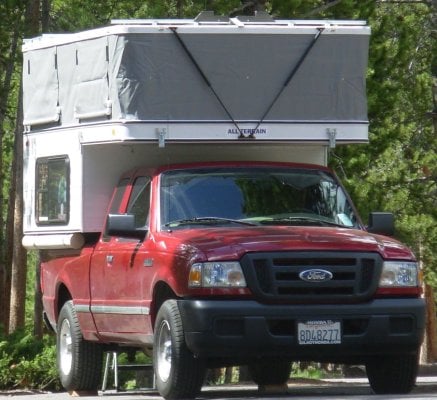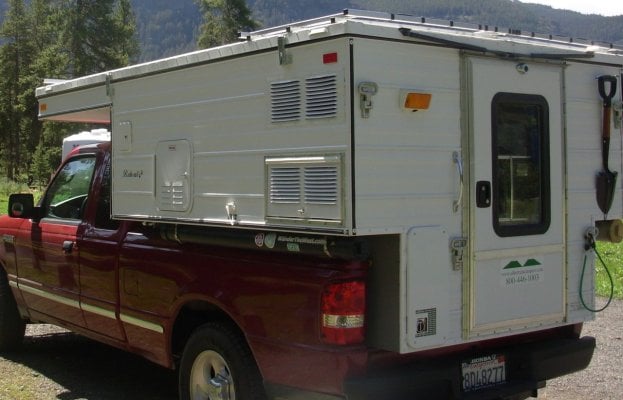I put this in another thread recently and it should probably be in this thread...
This relates to,
1) the force of the gas struts based on having a solar panel far forward on the roof (fixed, not removeable), and kayaks or no kayaks on the roof (thinking ahead about the need to switch out gas struts depending on a variable roof load, and thus knowing what a person might want to purchase),
and,
2) that the two common brands of gas struts that have been mentioned often, are slightly different in length and not really interchangeable with each other (something mentioned in a previous message, I believe).
- - - - - - - - - - - - - - - - - - - - - - -
While doing my initial visit to ATC last year I got to try out raising a Bobcat roof without the gas sturts and that made me decide on getting the ATC supplied Suspa 40 lb gas struts installed at the time of build.
After picking up my Bobcat, the Suspa 40 lb gas struts worked really great, easy up and easy down... no problem with the front poping back up. I loved 'em.
- - - - - - - - -
Then I installed my 24 lb. solar panel as far forward as possible, virtually right at the front edge of the top.
Front is a little hard to raise up (but not as hard as without the solar and without the gas struts, like when I visited ATC) , and it comes down very easy, as in... I have to slow it down, but doable, no real porblems.
Rear works just about the same as prior to the solar panel, easy up & down.
- - - - - - - - -
Then I placed my two, 9' long, fat, lake kayaks (each weigh about 30 lbs) on the rear section of the roof using the Thule roof rack load bars, no special mounting components, just strapped to the horizontal racks which are covered with water pipe foam insulation tubes, with fore and aft safety lines attached to the kayaks.
Front behaved a little heavier, not too bad, however, it did take more effort to raise and I had to slow it down even more on the descent. 50 lb gas struts might be nice up front.
Rear was really hard to raise with the 40 lb gas struts, and it wanted to crash on the way down, not good at all.
- - - - - - - - -
So, I got a pair of the Ebay 60 lb'er gas struts from Strut-your-stuff (not made by Suspa). Put them on the rear with the top in the UP position (the only way to do that, IMO). They were just a little longer than the Suspa ones from ATC, and it was sort of hard to compress the gas struts to get them mounted. I tried to figure out a way to have a second set of top or bottom mounting brackets for the two different lengths of gas struts, but, after a while my brain hurt, and I didn't come up with a good solution (except to get some Suspa 60 lb gas struts that are the same length as the ATC supplied Suspa 40 lb'ers).
No kayaks on the roof yet. The front behaved the same as before, I still had the 40 lb'ers up there. The rear was just about impossible to drop from the inside. I had to step out the back door, stand on my back porch with my hands over the top of the roof and pull down with my body weight. Once down, it didn't want to go up on it's own, so, I'm OK.
Added the Kayaks.
The rear went up nice and came down nice from inside, 60 lb'ers are great, except for compressing them in the mounting, that was a bear.
The front was about the same as before, still had 40 lb'ers up there, wished I had 50 lb'ers.
- - - - - - - - -
So, I'm thinking this is OK, except for one thing, I'd like to get a pair of Suspa 60 lb'ers for the rear that are the same length as the Suspa 40 lb'ers, so it's easy to mount them using the brackets that ATC installed. On the rear I can just switch between the 40 lb'ers (no Kayaks) and 60 lb'ers (Kayaks to be carried) when I want to, and it's easy to do when standing on my back porch.
I remember a WTW message in this thread on the gas struts saying that the Suspa 50 lb gas struts were "custom built" and the cost went thru the roof (pun intended), so I'll live with the 40 lb'ers on the front.
So, that's my experience.
I'll probably have the Strut-your-stuff 60 lb'ers for sale (hardly used at all, with metal end fittings, not plastic end fittings) once I get the Suspa 60 lb'ers in hand. Anybody need non-Suspa, 60 lb'ers?
- - - - - - - - -
Update:
I sent Suspa an email (
esupport@suspa-inc.com) today and got a prompt reply on some part numbers and prices, not including shipping.
I've provided web links to some of the Suspa items.
Here's the web link to the
Suspa Online Web Store.
The original ATC supplied Suspa 40 lb gas struts on my Bobcat are part number # C16-15952 (page 145 in the Gas Spring Replacements section - sorry can't get the web link to work right).
Prices for other Suspa gas struts that are the same length with different forces are;
A pair of 50 lb =
C16-17336 $190/pair
A pair of 60 lb =
C16-10198 $60/pair
A pair of 70 lb = C16-19632 $190/pair (seems to be the wrong part number sent by eSuppport, part not found)
A pair of 80 lb =
C16-10944 $60/pair
Looks like the 50 lb & 70 lb ones are the custom made ones, at least by the indicated price of 3+x & 3-4 week delivery time.
So, I'm going to order the Suspa 60 lb'ers for the rear.
I don't think I'll be getting the 50 lb'ers for the front at their current price.
- - - - - - - - -
Hum, I wonder if you can mix a 40 lb'er and a 60 lb'er on the front, without causing any damage to anything? If that works I could get the 100 lb lifting on the front, instead of the current 80 lb lifting. Maybe I'll cautiously try that with one of the 60 lb'er when they arrive. Naw, I'm guessing that one side would try to go up faster than the other side, might cause some damage to the inside lift panels.














